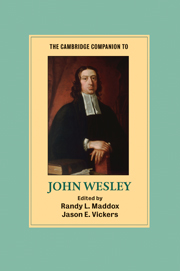Book contents
- Frontmatter
- Introduction
- Part I Wesley’s context
- Part II Wesley’s life
- Part III Wesley’s work
- 4 Wesley as revivalist/renewal leader
- 5 Wesley as preacher
- 6 Wesley as biblical interpreter
- 7 John Wesley as diarist and correspondent
- 8 John Wesley as editor and publisher
- 9 Wesley’s engagement with the natural sciences
- 10 Wesley as adviser on health and healing
- 11 Wesley’s theological emphases
- 12 Happiness, holiness, and the moral life in John Wesley
- 13 Wesley’s emphases on worship and the means of grace
- Part IV Wesley’s legacy
- Select bibliography
- Index
10 - Wesley as adviser on health and healing
from Part III - Wesley’s work
Published online by Cambridge University Press: 28 September 2010
- Frontmatter
- Introduction
- Part I Wesley’s context
- Part II Wesley’s life
- Part III Wesley’s work
- 4 Wesley as revivalist/renewal leader
- 5 Wesley as preacher
- 6 Wesley as biblical interpreter
- 7 John Wesley as diarist and correspondent
- 8 John Wesley as editor and publisher
- 9 Wesley’s engagement with the natural sciences
- 10 Wesley as adviser on health and healing
- 11 Wesley’s theological emphases
- 12 Happiness, holiness, and the moral life in John Wesley
- 13 Wesley’s emphases on worship and the means of grace
- Part IV Wesley’s legacy
- Select bibliography
- Index
Summary
John Wesley's theological and literary productions are, by any standards, prodigious. Even within his lifetime, Wesley's output ran to thousands of pages, hundreds of volumes, which included sermons, journals, tracts, edited abridgements, and numerous other commentaries. Readers today, however, might be surprised to discover that a slender medical manual, written first in 1747 to “prepare and give” physic to the poor, ran to more editions and stayed in print longer than any of Wesley's other publications - twenty-three editions went to press although the Methodist leader was alive, with the last and thirty-seventh edition being published in 1859. Wesley's medical manual had broad reach geographically and was republished in Europe and the United States. Such sustained demand firmly established within eighteenth-century medicine the popular and controversial status of Primitive Physic: or, An Easy and Natural Method of Curing Most Diseases (1747). However, this has not been adequately reflected in historical scholarship of the period, which has tended to treat Wesley's text as idiosyncratic or backward-looking. This attitude has meant that scholars have failed to examine the theological, intellectual, and cultural resonances of Wesley's enormously successful medical work, which he believed helped to heal sickness, remove pain, and save lives.
- Type
- Chapter
- Information
- The Cambridge Companion to John Wesley , pp. 176 - 189Publisher: Cambridge University PressPrint publication year: 2009
- 2
- Cited by



